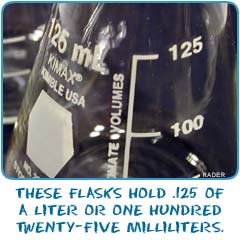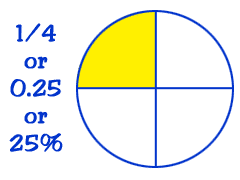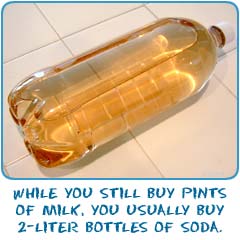
Decimals on the Right
Let's start by talking about what a decimal looks like. A decimal is a number that has a decimal point somewhere in the number. That makes sense. A decimal point is a dot, period, spot, or smudge. The number could look like any of these...1.2
1.23
1.234
1.2345
1234.234567890123456789
Do you see how there are numbers on the left and right side of the point? The numbers on the left side of the point represent whole numbers such as ones, tens, hundreds, and thousands. The numbers on the right side of the point are the decimal values. Those numbers represent values called tenths, hundredths, thousandths, and so on. The naming difference is in the "th". Tenths are the closest value to the point. There are no "oneths".
The decimal values are values that are less than one. For example, the number 1.2 is the number one and two tenths. 13.8 is the number thirteen and eight tenths. It's all about parts of a whole. Think about money for a second. U.S. money has cents. There are one hundred cents in a dollar. One penny is one cent. One cent is one hundredth of a dollar. Everyone's money, even in other countries, is based on decimals in one way or another.
International Differences
Since anyone can use a website, we aren't sure where you are today. If you are in a European country, you may write decimals with a comma instead of a dot. It may look different, but these values are exactly the same.Example:
1.25 is the same as 1,25
2,578.68941 is the same as 2.578,68941
It might seem a bit odd to see a comma in the area where you expect decimals to be. On this site, we're going to stick with the United States version of decimal writing so you don't have those problems. While you might put a comma in large whole numbers, there are no commas in the decimal values. Everyone who does math gets a bit confused with some examples when they travel around the world.
Example:
578.689 in the U.S. is technically the same as 578,689 in Europe.
The European version sure looks like a whole number, but that comma acts as a decimal point.
You just need to know that there are differences when you surf the web. Pay attention to the problems and exercises and you will be just fine.
Breaking It Down Into Tens
You've noticed how the numbers before and after the point use the same symbols (0-9). In the same way that our whole number system is based on tens, the decimal system is also based on tens. For example, there are ten tenths in a whole number. There are ten hundredths to every tenth. It goes on like that.The tenths are the largest amount less than a whole number in the decimal system. There are no oneths. As the "th" values get larger names, the values themselves get smaller. For example, four hundred thousandths is a much smaller number than four hundredths.
Examples:
• Tenths (0.x)
• Hundredths (0.0x)
• Thousandths (0.00x)
• Ten thousandths (0.000x)
• Hundred thousandths (0.0000x)

Fractions and Decimals
Fractions and decimals are related because they both describe values that are smaller than one. They are called rational numbers. If you look at a fraction as one number divided by another, the quotient can be a decimal value. Examples:
Examples:1/4 is one quarter.
1 divided by 4 is equal to 0.25.
0.25 is the decimal equivalent to 1/4.
36/288 is one complex fraction.
36 divided by 288 is equal to 0.125.
0.125 is the decimal equivalent to 36/288.
Related Activities

|
Adding Tenths on a Number Line
- Play Activity |

|
Identify Thousandth Values
- Play Activity |

The Metric System
The metric system is a measuring system we use some of the time in the United States. Other countries around the world use the system for everything. The metric system is based on tens and uses decimals all of the time. You will learn about the system in school math classes and eventually in science classes. While the metric system is super easy to understand, it is a bit difficult to switch from the U.S Customary System of units and measurements. Here are some examples of metric values that use decimals.• A kilometer is one thousand (1,000) meters.
• Five hundred (500) meters is 0.5 of a kilometer.
• A liter is one thousand (1,000) milliliters.
• A two-liter bottle holds 2,000 milliliters.

Compare those metric numbers to values we sometimes use in the U.S.
• A mile is one thousand seven hundred sixty (1,760) yards.
• Eight hundred eighty (880) yards is 0.5 of a mile.
• A gallon is one hundred twenty-eight (128) fluid ounces.
• A two-gallon bottle of water holds two hundred fifty-six (256) fluid ounces.
• One pound is sixteen (16) ounces.
See how it's easier to do the math when everything uses a counting base of ten? Just remember that the metric system uses decimals all of the time. If you want to be a scientist, you will use the metric system for every lab and every project. It makes life so much easier than other measurement systems.
Think about the two systems before you do more work with decimals. Why do you ask for a pound and a half of meat at the store instead of twenty-four (24) ounces? Do you think the person working behind the counter would know how much twenty-four ounces is? Try it and see if you get the right amount of food. Do you think it might be easier to ask for five hundred grams of meat if everyone knows a kilogram is one thousand grams?
Related Activities

|
Comparing the Sums of Simple Decimals
- Play Activity |

|
Subtracting Decimals with Tenths
- Play Activity |
► NEXT PAGE ON FRACTIONS & DECIMALS
► NEXT STOP ON SITE TOUR
► RETURN TO TOP OF PAGE
► Or search the sites...
► NEXT STOP ON SITE TOUR
► RETURN TO TOP OF PAGE
► Or search the sites...

- Overview
- Number Types
- Factors
- Fractions
- Decimals
- Percentages
- Estimation
- Ratios
- Money
- Activities
- More Maths Topics

Useful Reference Materials
Wikipedia:https://en.wikipedia.org/wiki/Fraction_%28mathematics%29
Encyclopædia Britannica:
http://www.britannica.com/topic/fraction
University of Delaware:
https://sites.google.com/a/udel.edu/fractions/



